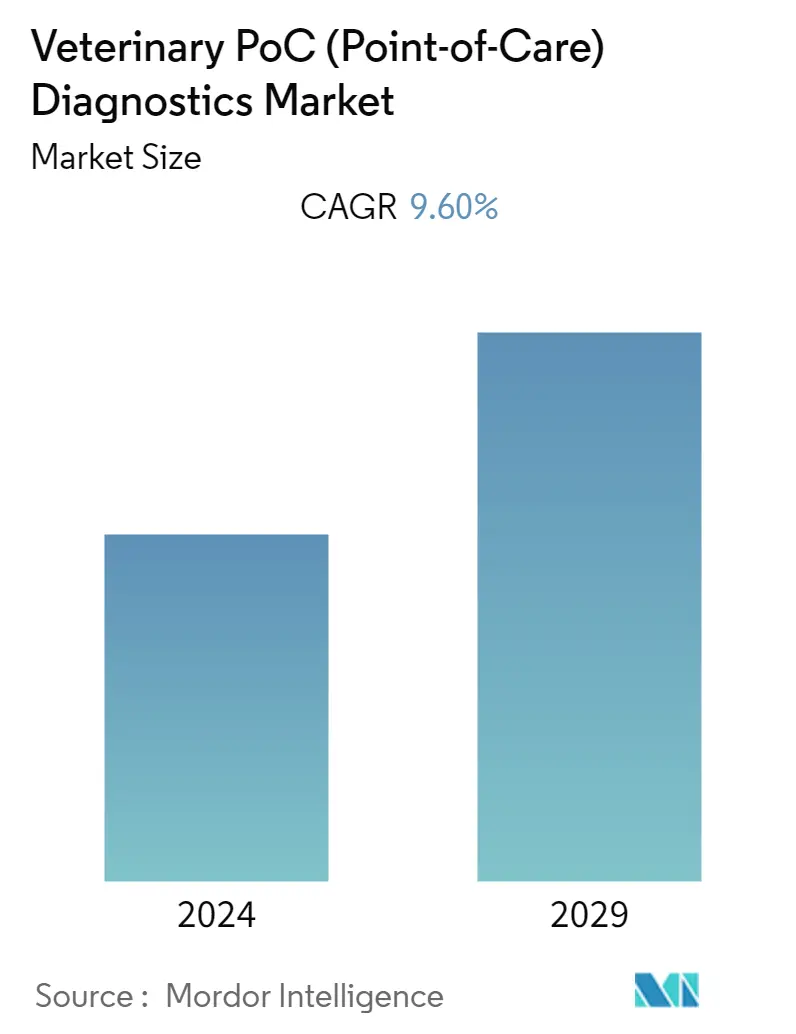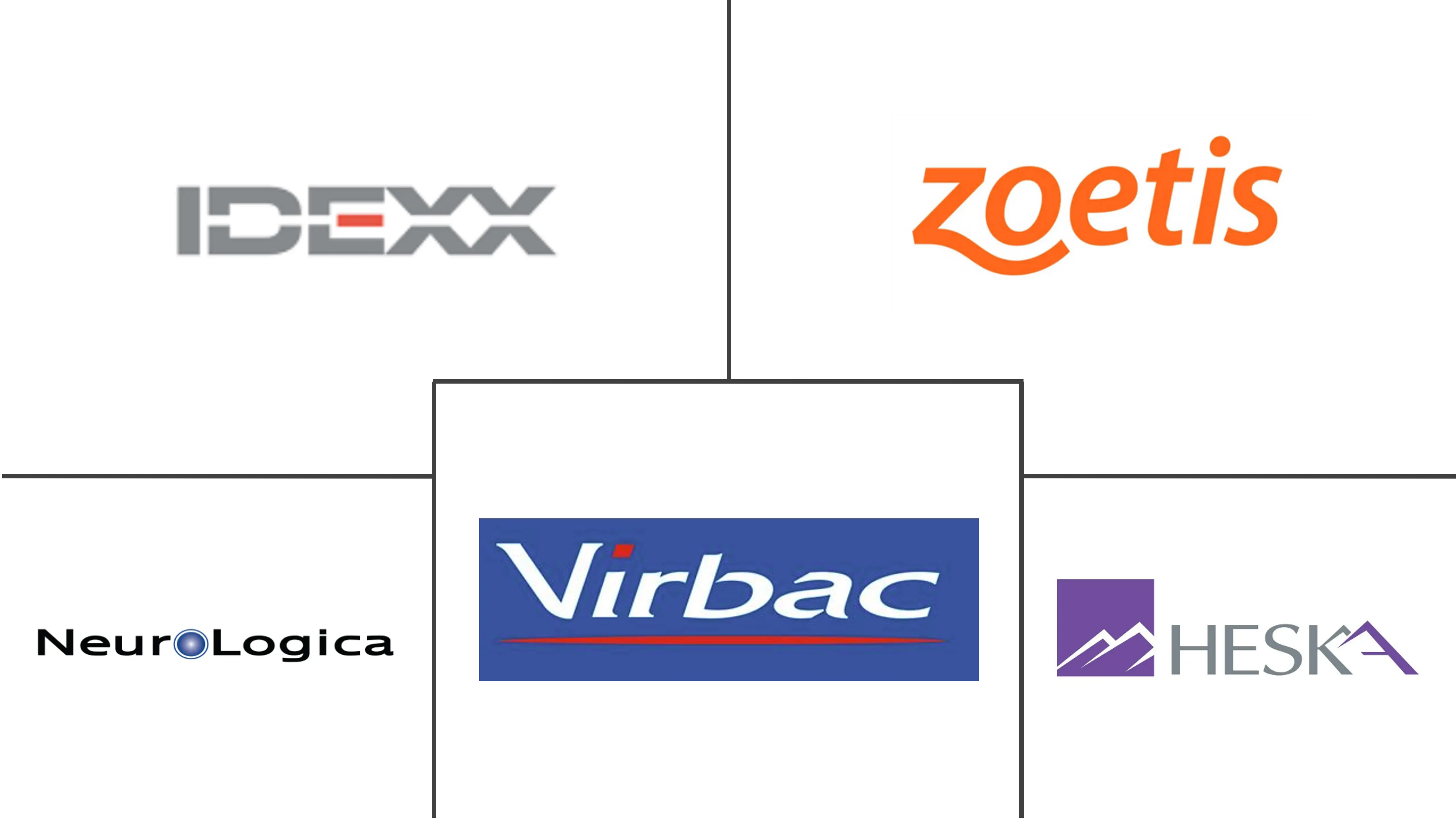Market Size of Veterinary PoC (Point-of-Care) Diagnostics Industry

| Study Period | 2019 - 2029 |
| Base Year For Estimation | 2023 |
| CAGR | 9.60 % |
| Fastest Growing Market | Asia-Pacific |
| Largest Market | North America |
| Market Concentration | Medium |
Major Players
*Disclaimer: Major Players sorted in no particular order |
Veterinary PoC (Point-of-Care) Diagnostics Market Analysis
The Veterinary PoC (Point-of-Care) Diagnostics Market is expected to register a CAGR of 9.6% over the forecast period.
The COVID-19 pandemic has initially had a slightly positive impact on the veterinary PoC (point-of-care) diagnostics market. At the onset of the novel coronavirus pandemic, a public lockdown was imposed. Due to the imposition of lockdown and social distancing, several factors led to a surge in pet adoption by people, which was helpful in getting rid of the loneliness and anxiety caused by isolation. As COVID-19 emerged from animals, the government, healthcare organizations, and media helped to raise awareness about the risk of zoonotic disease spread during the pandemic. The collective efforts of these bodies lead to increased knowledge of zoonotic infections, prevention, and hygiene for companion and livestock animals. Some of the leading companies operating in the veterinary PoC diagnostic market have witnessed mild growth in their revenues. For instance, IDEXX reported growth of only 3% from 2019 to 2020 and 27% growth from 2020 to 2021 in its veterinary, software, services, and diagnostic imaging systems segments.
Further, Zoetis reported revenue growth of only 7% from 2019 to 2020 and 16% growth in its revenue from 2020 to 2021 in its veterinary, software, services, and diagnostic imaging systems segments. In March 2020, IDEXX announced that it had found no positive results in pets with SARS-CoV-2. The company evaluated thousands of feline and canine samples to validate the new veterinary diagnostic test for the virus. This shows that the market for veterinary PoC has been mildly impacted by the pandemic, and the companies achieved robust growth in 2021. Thus, the COVID-19 outbreak had a mildly positive impact on the market's growth in its preliminary phase, with more pet adoptions and an increase in veterinary PoC testing. Moreover, the market is expected to grow further at a stable pace with the increasing demand for zoonotic disease diagnosis globally.
Furthermore, the increasing prevalence of zoonotic infections and their transmission to humans globally aided market growth. The market's growth is driven by the rising prevalence of zoonotic diseases and their transmission to humans, increasing pet adoptions and the number of veterinary healthcare professionals, and increasing research into veterinary disease diagnosis. According to a study published in the Faculty Reviews 2022, over 60% of the infections in humans have zoonotic origins, and over 40% of the infections have either emerged from non-zoonotic sources or co-evolved with humans. Recently, there have been several zoonotic-origin infections that resulted in an outbreak and have impacted the human population globally. Apart from the novel coronavirus, some zoonotic infections have recently impacted humans, including swine flu, Ebola, monkeypox, the zika virus, and others. According to the World Health Organization (WHO) 2022, there were over 130 reported cases of Ebola in the Democratic Republic of the Congo in 2020. On April 23, 2022, an outbreak of Ebola was declared by the health authority of the Congo. In July 2022, WHO declared the current monkeypox outbreak a public health emergency of international concern (PHEIC), overriding the WHO Emergency Committee. By November 2022, WHO had confirmed over 80,221 cases and 52 deaths from monkeypox in over 110 nations.
In addition, research in the area of effective diagnosis and monitoring of zoonotic diseases has been rising. The advancing research and use of veterinary PoC testing have helped in the management of antimicrobial resistance. According to the October 2022 issue of Acta Veterinaria Brno, the incoming advanced technologies in veterinary PoC include the development of microfluidics, lab-on-a-chip technologies, biosensors, bioanalytical platforms, complementary technologies, and others. Over time, PoC diagnosis contributes significantly to the monitoring of zoonotic diseases. As per the International Journal of Infectious Diseases 2021, current efforts are being made to utilize PoC for zoonotic diseases such as zoonotic tuberculosis (zTB), which accounts for 1.4% of the cases of global tuberculosis. Further, CRISPR-based technologies as a platform for zoonotic PoC testing are being researched. A study published in the journal Methods 2022 has highlighted the use of CRISPR Cas for diagnosis and point-of-care nucleic acid detection by using the Cas proteins (Cas3, Cas9, Cas12, etc.) to detect various infectious agents.
Therefore, owing to the aforementioned factors, it is anticipated that the studied market will witness growth over the analysis period. However, the high cost of veterinary imaging instruments will likely impede the market's growth.
Veterinary PoC (Point-of-Care) Diagnostics Industry Segmentation
As per the scope of the report, Veterinary PoC (Point-of-Care) is diagnostic testing of animals in which the testing is done near the place of treatment, such as a hospital, clinic, etc. The result of the PoC test may change the treatment and care regime of a diseased animal. The Veterinary PoC (Point-of-Care) Diagnostics Market is segmented by Product Type (Consumables, Reagents & Kits, and Analyzing Instruments & Devices), By Animal Type (Companion Animals (Dogs, Cats, Horses, and Others), and by Livestock Animals (Cattle, Swine, Poultry, and Others)), By Sample Type (Blood/Plasma/Serum, Urine, Fecal, and Others), By Test Type (Molecular Diagnostics, Immunodiagnostics, Hematology, Urinalysis, Clinical Biochemistry, and Other Technologies), By End User (Veterinary Hospitals & Clinics, and Home Care Settings), and Geography (North America, Europe, Asia-Pacific, Middle East and Africa, and South America). The market report also covers the estimated market sizes and trends for 17 different countries across major regions globally. The report offers the value (in USD million) for the above segments.
| By Product Type | |
| Consumables, Reagents & Kits | |
| Analysing Instruments & Devices |
| By Animal Type | ||||||
| ||||||
|
| By Test Type | |
| Molecular Diagnostics | |
| Immunodiagnostics | |
| Hematology | |
| Urinalysis | |
| Clinical Biochemistry | |
| Other Technologies (histology, cytology, and toxicology) |
| By End User | |
| Veterinary Hospitals & Clinics | |
| Home Care Settings |
| Geography | ||||||||
| ||||||||
| ||||||||
| ||||||||
| ||||||||
|
Veterinary PoC (Point-of-Care) Diagnostics Market Size Summary
The veterinary PoC (Point-of-Care) diagnostics market is poised for significant growth, driven by the increasing prevalence of zoonotic diseases and the rising demand for rapid diagnostic solutions. The market has experienced a mildly positive impact from the COVID-19 pandemic, which heightened awareness of zoonotic infections and spurred pet adoptions. This surge in pet ownership, coupled with the need for effective disease diagnosis and prevention, has contributed to the market's expansion. The development and adoption of advanced technologies such as microfluidics, lab-on-a-chip, and CRISPR-based platforms are further propelling the market forward. These innovations are crucial for managing antimicrobial resistance and enhancing the diagnosis of zoonotic diseases, which have significant implications for both animal and human health.
North America is expected to lead the market due to its robust veterinary healthcare infrastructure and the presence of key industry players. The region's growth is supported by increased veterinary patient visits and ongoing research into veterinary disease diagnostics. Companies like IDEXX, Zoetis, and Heska Corporation are at the forefront, driving innovation and expanding their product offerings. The market is moderately consolidated, with a few major players dominating both global and regional markets. The demand for consumables, reagents, and kits is also on the rise, fueled by the growing volume of diagnostic tests for various conditions. Despite the high cost of veterinary imaging instruments posing a challenge, the market is anticipated to witness steady growth over the forecast period.
Veterinary PoC (Point-of-Care) Diagnostics Market Size - Table of Contents
-
1. MARKET DYNAMICS
-
1.1 Market Overview
-
1.2 Market Drivers
-
1.2.1 Rising Prevalence Of Zoonotic Diseases And Their Transmission To Humans
-
1.2.2 Increasing Pet Adoptions And Numbers Of Veterinary Healthcare Professionals
-
1.2.3 Increasing Research Into Veterinary Disease Diagnosis
-
-
1.3 Market Restraints
-
1.3.1 High Cost Of Analysing Instruments & Devices
-
-
1.4 Porter Five Forces
-
1.4.1 Threat of New Entrants
-
1.4.2 Bargaining Power of Buyers/Consumers
-
1.4.3 Bargaining Power of Suppliers
-
1.4.4 Threat of Substitute Products
-
1.4.5 Intensity of Competitive Rivalry
-
-
-
2. MARKET SEGMENTATION (Market Size by Value - USD million)
-
2.1 By Product Type
-
2.1.1 Consumables, Reagents & Kits
-
2.1.2 Analysing Instruments & Devices
-
-
2.2 By Animal Type
-
2.2.1 Companion Animals
-
2.2.1.1 Dogs
-
2.2.1.2 Cats
-
2.2.1.3 Horses
-
2.2.1.4 Others (fish, guinea pigs, hamsters, turtle, rabbits, birds, and ferrets)
-
-
2.2.2 Livestock Animals
-
2.2.2.1 Cattle
-
2.2.2.2 Swine
-
2.2.2.3 Poultry
-
2.2.2.4 Others (donkey, sheep, camel, deer, and yak)
-
-
-
2.3 By Test Type
-
2.3.1 Molecular Diagnostics
-
2.3.2 Immunodiagnostics
-
2.3.3 Hematology
-
2.3.4 Urinalysis
-
2.3.5 Clinical Biochemistry
-
2.3.6 Other Technologies (histology, cytology, and toxicology)
-
-
2.4 By End User
-
2.4.1 Veterinary Hospitals & Clinics
-
2.4.2 Home Care Settings
-
-
2.5 Geography
-
2.5.1 North America
-
2.5.1.1 United States
-
2.5.1.2 Canada
-
2.5.1.3 Mexico
-
-
2.5.2 Europe
-
2.5.2.1 Germany
-
2.5.2.2 United Kingdom
-
2.5.2.3 France
-
2.5.2.4 Italy
-
2.5.2.5 Spain
-
2.5.2.6 Rest of Europe
-
-
2.5.3 Asia-Pacific
-
2.5.3.1 China
-
2.5.3.2 Japan
-
2.5.3.3 India
-
2.5.3.4 Australia
-
2.5.3.5 South Korea
-
2.5.3.6 Rest of Asia-Pacific
-
-
2.5.4 Middle East and Africa
-
2.5.4.1 GCC
-
2.5.4.2 South Africa
-
2.5.4.3 Rest of Middle East and Africa
-
-
2.5.5 South America
-
2.5.5.1 Brazil
-
2.5.5.2 Argentina
-
2.5.5.3 Rest of South America
-
-
-
Veterinary PoC (Point-of-Care) Diagnostics Market Size FAQs
What is the current Veterinary PoC (Point-of-Care) Diagnostics Market size?
The Veterinary PoC (Point-of-Care) Diagnostics Market is projected to register a CAGR of 9.60% during the forecast period (2024-2029)
Who are the key players in Veterinary PoC (Point-of-Care) Diagnostics Market?
IDEXX, Zoetis, Virbac, NeuroLogica Corp. and Heska Corporation are the major companies operating in the Veterinary PoC (Point-of-Care) Diagnostics Market.

